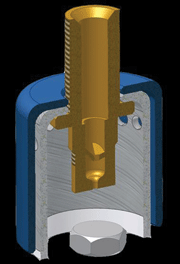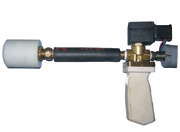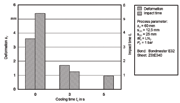E-Archive
Science Update
in Vol. 9 - November Issue - Year 2008
Cryogenic Disassembly

Prof. Eckartt Uhlmann

Dipl.-Ing. (FH) Michael Kretzschmar M.Sc.

Fig. 1: Spray cap with atomiser nozzles, half section

Fig. 2: Cooling device with spray cap

Fig. 3: Broken M8 hexagon screws, left without, right with cryogenic pre-treatment

Fig. 4: Deformation and impact time depending to cooling time, width of the bond 25 mm
New Method for Environmentally Neutral Dismantling
Motivation
The directive of the European Union concerning end-of-life vehicles and electronic devices yields new conditions for dismantling. Industry and research must therefore optimise dismantling and recycling processes of end-of-life products in an ecological and economic manner. The processes must allow that products, assembly groups and materials can return into product and material flow cycles /1, 2, 3/. To reach this goal the dismantling must be free of secondary damaging of the dismantled parts. Process forces and their contact time must therefore be reduced. In this paper screwed joints and bonds were the object for the dismantling tests. Screwed joints must be destroyed when they cannot be unscrewed with common tools, as a result of corrosion for example.
Hybrid Cryogenic-Disassembly-Tool
The goal of this research project was the development of a hybrid Cryogenic-Separating-Disassembly-Tool, which combines treatment with liquid nitrogen and a pneumatic chisel hammer. Pneumatic driven tools have the advantage that they are small and light. To keep these advantages the hybrid tool was designed as a modular tool, such that there is one cooling and one cutting device.
By using liquid nitrogen for cooling, the Leidenfrost-effect was taken into account. The Leidenfrost-effect means the temporal lengthening phase changes, when a liquid is superimposed to a surface which is colder than the liquid. If a liquid can vaporise in a short time-frame a gas cushion is built underneath. This gas cushion insulates the liquid from the surface, so that the heat transfer is slowed down. To reduce this effect, atomiser nozzles were used. These nozzles generate small droplets of liquid nitrogen, which vaporises very quickly and completely when hitting the surface. Thus the gas cushion is avoided and the heat transfer is accelerated. For a further improvement of the cooling effect a spray cap was developed which allows a local limitation of the cooling area, Fig. 1. The entire cooling device is shown in Fig. 2.
Technological analysis
The analysis involved the determination of the cooling power by using the atomiser nozzles and the spray cap. For that purpose holes were drilled sideways into an M 10 hexagon screw and thermocouples were placed in the holes. The head of the screw was then treated with liquid nitrogen. This test showed that 120 s cooling time should suffice to break the screw in brittle conditions. Impact tests showed that a cooling time of 180 s was necessary to embrittle the screw and break it. This can be traced back to the different thermal expansion coefficients and different thickness of the screw and the base. This leads to a further tension of the screw and therefore to a rise in contact pressure at the head of the screw and at the nut. The impulse of the chisel hammer is therefore insufficient to overcome this contact pressure. After a cooling time of 180 s the contact pressure has decreased, thus enabling fracture. Without cooling it was not possible to break an M 10 screw with the chisel hammer. After the pre-treatment with the cooling device the screw breaks within one second and was completely brittle. Fig. 3 shows an example of an M 8 screw.
The breaking tests of bonds were conducted with metal sheets, in reference to the DIN EN 1465 /4/. Sheets with a width of 25 mm were initially used and 50 mm and 75 mm sheets were also investigated. The length of the bond was 12,5 mm at all time. The sheets were clamped at a defined length, the chisel hammer was applied in a defined angle and the bond was separated. Breaking the bonds was also possible without cooling, but secondary damages occur. The secondary damaging was defined as scratches on the surface as a subjective value and the deformation of the sheets as an objective value. The deformation is due to the clamping of the sheets in addition to the force of the chisel hammer. Fig. 4 shows that the higher the cooling the lower the deformation and eventually no deformation for a cooling time of five seconds.
Conclusion
The developed hybrid Cryogenic-Separating-Disassembly-Tool allows secondary damage free dismantling. The process time could not be reduced, but the process forces and the contact time could be reduced. Nevertheless there were some significant advantages compared to conventional disassembly processes. Assembly groups can disassemble without causing damage to the parts, meaning they can be used continuously without any post-treatment. Hence an additional value is generated compared to the value of the raw material in case of a destroying disassembly. Besides compliance with the legal guidelines an economical benefit is therefore achieved. Furthermore this technology can be used for dismantling harmful material, such asbestos. Due to the damage free dismantling non carcinogenic fibres will occur, which improves employee safety levels.
Outlook
Future development should aim at the transfer of the developed process into further application areas. This includes for example degumming of large vessels used in the chemical industry, dismantling of asbestos and dismantling of composite materials. The technology can also be used as a repair kit, e. g. for repairing bonded structure.
The presented research was made possible by the Deutsche Forschungsgesellschaft which provides funding for this research project.
References
/1/ Fried, F.; Hagen, T.; Wörle, G: Methods and elements towards sustainable products. BMW´ s strategy, Proceeding of the first international Conference on Design for recycling and the environment, First conference for design and manufacture for sustainable development, Liverpool, England, S. 13-52, 2002.
/2/ N.N.: Richtlinie des Europäischen Parlaments und des Rates über Elektro- und Elektronikaltgeräte, EU, Brüssel, Belgien, 2000.
/3/ N.N.: Alle alten Elektrogeräte werden verwendet, Handelsblatt,
Bonn, S. 6, 15.06.1999.
/4/ N.N.: DIN EN 1465 - Klebstoffe – Bestimmung der Zugscherfestigkeit hochfester Überlappungsklebungen, Beuth-Verlag 1995
Technical University Berlin
Pascalstraße 8-9, 10587 Berlin, Germany
Tel- +49.30.314 - 24 96 0, Fax 314 - 25 89 5
E-Mail: kretzschmar@iwf.tu-berlin.de
www.iwf.tu-berlin.de/fachgebiete/fer



























